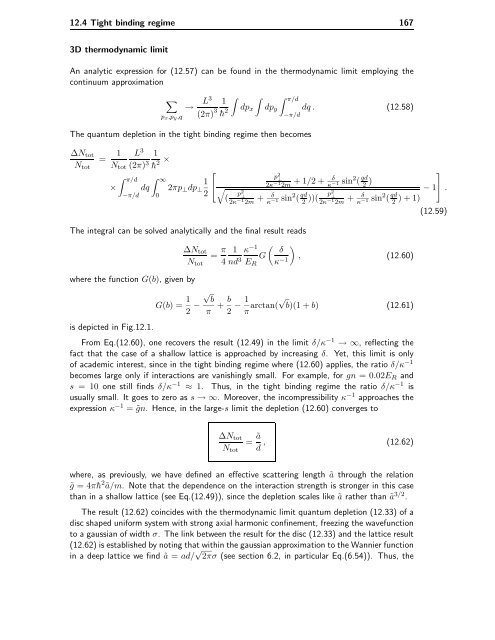Bose-Einstein Condensates in Rotating Traps and Optical ... - BEC
Bose-Einstein Condensates in Rotating Traps and Optical ... - BEC
Bose-Einstein Condensates in Rotating Traps and Optical ... - BEC
You also want an ePaper? Increase the reach of your titles
YUMPU automatically turns print PDFs into web optimized ePapers that Google loves.
12.4 Tight b<strong>in</strong>d<strong>in</strong>g regime 167<br />
3D thermodynamic limit<br />
An analytic expression for (12.57) can be found <strong>in</strong> the thermodynamic limit employ<strong>in</strong>g the<br />
cont<strong>in</strong>uum approximation<br />
<br />
px,py,q<br />
→ L3<br />
(2π) 3<br />
1<br />
¯h 2<br />
<br />
dpx<br />
The quantum depletion <strong>in</strong> the tight b<strong>in</strong>d<strong>in</strong>g regime then becomes<br />
∆Ntot<br />
=<br />
Ntot<br />
1 L<br />
Ntot<br />
3<br />
(2π) 3<br />
1<br />
2 ×<br />
¯h<br />
⎡<br />
π/d ∞ 1<br />
× dq 2πp⊥dp⊥ ⎣<br />
−π/d 0<br />
2 p<br />
(<br />
2 ⊥<br />
2κ−12m <br />
π/d<br />
dpy dq . (12.58)<br />
−π/d<br />
p 2 ⊥<br />
2κ −1 2m<br />
+1/2+ δ<br />
κ −1 s<strong>in</strong> 2 ( qd<br />
2 )<br />
δ + κ−1 s<strong>in</strong>2 ( qd<br />
2 ))(<br />
p2 ⊥<br />
2κ−12m The <strong>in</strong>tegral can be solved analytically <strong>and</strong> the f<strong>in</strong>al result reads<br />
∆Ntot<br />
Ntot<br />
= π 1<br />
4 nd3 κ −1<br />
ER<br />
+ δ<br />
κ −1 s<strong>in</strong> 2 ( qd<br />
2 )+1)<br />
<br />
δ<br />
G<br />
κ−1 <br />
, (12.60)<br />
where the function G(b), givenby<br />
G(b) = 1<br />
2 −<br />
√<br />
b b 1<br />
+ −<br />
π 2 π arctan(√b)(1 + b)<br />
is depicted <strong>in</strong> Fig.12.1.<br />
(12.61)<br />
From Eq.(12.60), one recovers the result (12.49) <strong>in</strong> the limit δ/κ−1 →∞, reflect<strong>in</strong>g the<br />
fact that the case of a shallow lattice is approached by <strong>in</strong>creas<strong>in</strong>g δ. Yet, this limit is only<br />
of academic <strong>in</strong>terest, s<strong>in</strong>ce <strong>in</strong> the tight b<strong>in</strong>d<strong>in</strong>g regime where (12.60) applies, the ratio δ/κ−1 becomes large only if <strong>in</strong>teractions are vanish<strong>in</strong>gly small. For example, for gn =0.02ER <strong>and</strong><br />
s = 10 one still f<strong>in</strong>ds δ/κ−1 ≈ 1. Thus, <strong>in</strong> the tight b<strong>in</strong>d<strong>in</strong>g regime the ratio δ/κ−1 is<br />
usually small. It goes to zero as s →∞. Moreover, the <strong>in</strong>compressibility κ−1 approaches the<br />
expression κ−1 =˜gn. Hence, <strong>in</strong> the large-s limit the depletion (12.60) converges to<br />
∆Ntot<br />
Ntot<br />
= ã<br />
, (12.62)<br />
d<br />
where, as previously, we have def<strong>in</strong>ed an effective scatter<strong>in</strong>g length ã through the relation<br />
˜g =4π¯h 2 ã/m. Note that the dependence on the <strong>in</strong>teraction strength is stronger <strong>in</strong> this case<br />
than <strong>in</strong> a shallow lattice (see Eq.(12.49)), s<strong>in</strong>ce the depletion scales like ã rather than ã 3/2 .<br />
The result (12.62) co<strong>in</strong>cides with the thermodynamic limit quantum depletion (12.33) of a<br />
disc shaped uniform system with strong axial harmonic conf<strong>in</strong>ement, freez<strong>in</strong>g the wavefunction<br />
to a gaussian of width σ. The l<strong>in</strong>k between the result for the disc (12.33) <strong>and</strong> the lattice result<br />
(12.62) is established by not<strong>in</strong>g that with<strong>in</strong> the gaussian approximation to the Wannier function<br />
<strong>in</strong> a deep lattice we f<strong>in</strong>d ã = ad/ √ 2πσ (see section 6.2, <strong>in</strong> particular Eq.(6.54)). Thus, the<br />
⎤<br />
− 1⎦<br />
.<br />
(12.59)




